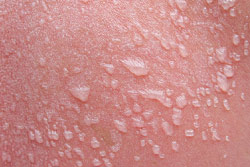


And avoid harsh soaps and washing more than once or twice daily, which may aggravate the condition. Don’t pick pimples: Breaking the skin can lead to infection. Home care: Usually infant acne clears up within a few months without treatment. Infant acneĬause: Spurred by hormones passed from mother to baby before birth, glands in the skin produce excess oil and become clogged. See a doctor: If the rash does not disappear within a few days, your family physician or paediatrician may suggest a mild corticosteroid cream to speed healing.

Opt for cotton clothing, which allows air to circulate. Patting with a damp cloth may also cool the skin. Home care: Remove the offending fabric to let heat dissipate.
Pinpoint red dots on skin after being in sun plus#
Fever can also spark heat rash.Ĭause: Overheating plus blocked sweat glands. Where: In skin creases, areas covered by clothing or on skin that’s stayed in prolonged contact with a surface - like a car seat - under hot, sticky conditions. Look for: Tiny reddish specks which may turn into small, fluid-filled blisters. Red “satellite” dots around the edges signal a yeast rash, which usually requires treatment with a prescription anti-fungal cream. See a doctor: If the skin becomes broken or oozes fluid, or if the rash does not start improving after a few days, your family doctor or paediatrician may recommend a cortisone-based salve to hasten healing. Apply petroleum jelly or zinc oxide cream to shield sensitive skin from urine and stool. Cleanse the area with warm water (soaps and wipes may remove the skin’s protective oils) and pat dry. Home care: Changing diapers frequently and airing baby’s bottom can help keep diaper rash at bay. In other cases, a yeast called candida (the culprit behind thrush) multiplies out of control when something upsets the normal balance of bacteria that live on the skin. John’s Michelle Ponti, paediatrician, London, Ontario Rashes in babies and toddlers: Age 0-3Ĭause: Enzymes in stool breach the skin’s protective barrier, causing irritation that’s aggravated by moisture and rubbing. Our expert panel: Richard Haber, dermatologist, University of British Columbia Scott Murray, dermatologist, Dalhousie University, Halifax Ian Landells, dermatologist, Memorial University, St. Here’s how you can identify rashes in kids, and what you can do about them. But even this amazing material can fall prey to problems. (nevermind that i have other symptoms matching lupus.) This reaction seems to be fairly unique, and I'm wondering what other people know about it.A self-mending covering that automatically adjusts to changes in body shape, maintains a comfortable temperature, fends off bacteria and even senses environmental changes - no man-made fabric can match the fantastic feats performed by your child’s skin. Hopefully this can be a symptom of something other than Lupus, because I've never been tested or diagnosed with it. Looked like someone took a red ink pen and dotted them all over my legs (especially the shin area). But that is basically the only time i get them is from the sun. It took about 3-4 days and they were gone. 4th of July, I got sunburned for the first time since I was diagnosed a little over a year ago, my legs were really burned.and i got those red spots on my lower legs (got them once before before the diagnoses). Yes, I get them on my legs if I've been in the sun, which I know I shouldn't do. Question: Does anyone have a lot of red dots - they are like little broken capillaries - on their trunks or arms or legs? Is this a symptom of lupus? The rhuematologist I just saw simply ignored my questions about this. I've never talked to anyone that shared this reaction, so when I found a post (after googling) describing my symptom, it caught my eye. They usually go away after a few days, and don't hurt. I get tiny little red/purple spots under the skin all over my legs after prolonged sun exposure.


 0 kommentar(er)
0 kommentar(er)
